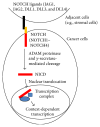Roles of NOTCH1 as a Therapeutic Target and a Biomarker for Lung Cancer: Controversies and Perspectives
- PMID: 26491213
- PMCID: PMC4600509
- DOI: 10.1155/2015/520590
Roles of NOTCH1 as a Therapeutic Target and a Biomarker for Lung Cancer: Controversies and Perspectives
Abstract
Lung cancer is one of the most common types of human malignancies and the leading cause of cancer-related death. Patients with surgically resectable early stage lung cancer are more likely curable, but currently only a small population of patients can be diagnosed at such a stage, partly due to our incomplete understanding of the biology of lung cancer and the lack of diagnostic and prognostic biomarkers. Recent studies have shown that NOTCH1 is a critical regulator of human carcinogenesis and has been implicated in multiple steps of cancer development and progression. Herein, we review recent findings about the role of NOTCH1 in lung cancer and discuss its potential usefulness as both a therapeutic target and a biomarker for lung cancer.
Figures


Similar articles
-
Regulation of the epithelial to mesenchymal transition and metastasis by Raf kinase inhibitory protein-dependent Notch1 activity.Oncotarget. 2016 Jan 26;7(4):4632-46. doi: 10.18632/oncotarget.6728. Oncotarget. 2016. PMID: 26716415 Free PMC article.
-
Meta-analysis reveals the correlation of Notch signaling with non-small cell lung cancer progression and prognosis.Sci Rep. 2015 May 21;5:10338. doi: 10.1038/srep10338. Sci Rep. 2015. PMID: 25996086 Free PMC article.
-
Cross-talk between endothelial cells and tumor via delta-like ligand 4/Notch/PTEN signaling inhibits lung cancer growth.Oncogene. 2012 Jun 7;31(23):2899-906. doi: 10.1038/onc.2011.467. Epub 2011 Oct 17. Oncogene. 2012. PMID: 22002304
-
An update on sputum MicroRNAs in lung cancer diagnosis.Diagn Cytopathol. 2016 May;44(5):442-9. doi: 10.1002/dc.23444. Epub 2016 Feb 11. Diagn Cytopathol. 2016. PMID: 26865409 Review.
-
The mTOR pathway in lung cancer and implications for therapy and biomarker analysis.J Thorac Oncol. 2012 Jun;7(6):947-53. doi: 10.1097/JTO.0b013e31825581bd. J Thorac Oncol. 2012. PMID: 22588151 Review.
Cited by
-
Distinct co-acquired alterations and genomic evolution during TKI treatment in non-small-cell lung cancer patients with or without acquired T790M mutation.Oncogene. 2020 Feb;39(9):1846-1859. doi: 10.1038/s41388-019-1104-z. Epub 2019 Nov 21. Oncogene. 2020. PMID: 31754213
-
Small-cell lung cancer: what we know, what we need to know and the path forward.Nat Rev Cancer. 2017 Dec;17(12):725-737. doi: 10.1038/nrc.2017.87. Epub 2017 Oct 27. Nat Rev Cancer. 2017. PMID: 29077690 Review.
-
Phosphorylation-dependent regulation of the NOTCH1 intracellular domain by dual-specificity tyrosine-regulated kinase 2.Cell Mol Life Sci. 2020 Jul;77(13):2621-2639. doi: 10.1007/s00018-019-03309-9. Epub 2019 Oct 11. Cell Mol Life Sci. 2020. PMID: 31605148 Free PMC article.
-
Notch Signaling Components: Diverging Prognostic Indicators in Lung Adenocarcinoma.Medicine (Baltimore). 2016 May;95(20):e3715. doi: 10.1097/MD.0000000000003715. Medicine (Baltimore). 2016. PMID: 27196489 Free PMC article.
-
Comparative genomic analysis of esophageal squamous cell carcinoma and adenocarcinoma: New opportunities towards molecularly targeted therapy.Acta Pharm Sin B. 2022 Mar;12(3):1054-1067. doi: 10.1016/j.apsb.2021.09.028. Epub 2021 Sep 30. Acta Pharm Sin B. 2022. PMID: 35530133 Free PMC article. Review.
References
-
- Chen W., Zheng R., Zeng H., Zhang S. The epidemiology of lung cancer in China. Journal of Cancer Biology & Research. 2014;2(1, article 1043)
Publication types
MeSH terms
Substances
Grants and funding
LinkOut - more resources
Full Text Sources
Other Literature Sources
Medical

